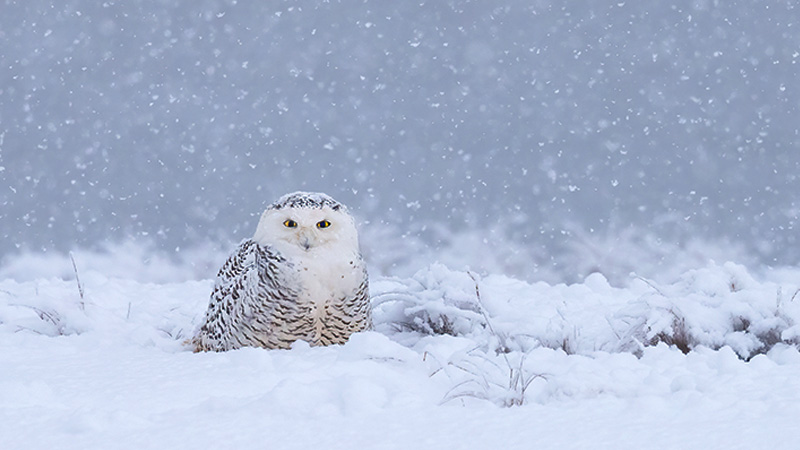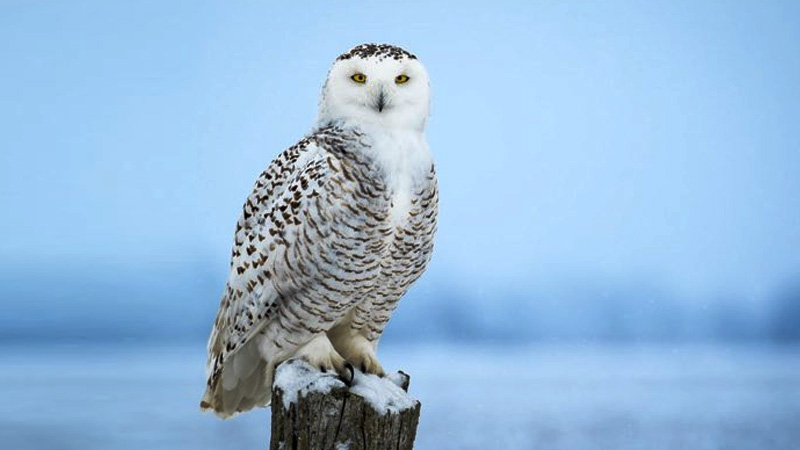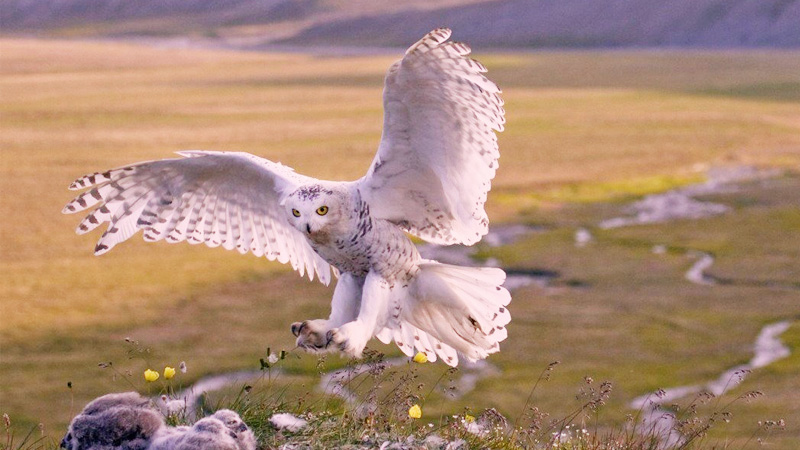The Snowy Owl, with its striking white plumage and piercing yellow eyes, is a captivating symbol of the Arctic wilderness. These majestic birds have long held a mysterious allure, capturing the imaginations of people around the world.
But beyond their enigmatic appeal lies a question of utmost significance: Is the Snowy Owl endangered? This question resonates deeply, for these Arctic residents are not only symbols of beauty but also indicators of the health of one of the most remote and pristine environments on Earth.
In this exploration, we embark on a journey into the heart of the Arctic to unravel the current status of the Snowy Owl. It is a quest that takes us into the vast, windswept landscapes where these magnificent birds make their home. It’s a journey through time, from ancient legends to the modern era of scientific inquiry.

Is the Snowy Owl Endangered?
No, the Snowy Owl (Bubo scandiacus) is not classified as an endangered species according to the International Union for Conservation of Nature (IUCN). However, the status of species can change over time due to various factors, including habitat loss, climate change, and human interference.
To provide you with the most accurate and up-to-date information, I recommend checking with the IUCN or a relevant wildlife conservation organization for the current status of the Snowy Owl.
Nonetheless, it is essential to understand the factors that have historically influenced the Snowy Owl’s conservation status and the ongoing challenges these birds face.
Historical Perspective
The Snowy Owl is primarily a circumpolar species, with a range that spans the Arctic tundra regions of North America, Europe, and Asia. Historically, they were not considered globally threatened, and their populations were relatively stable.
However, local or regional declines and fluctuations have been observed.
Factors Affecting Snowy Owl Populations
Snowy Owl populations are influenced by a complex interplay of environmental, ecological, and human factors. Understanding these dynamics is crucial for their conservation. Explore the key factors shaping the fate of these majestic Arctic birds.
Climate Change
One of the most significant threats to Snowy Owls is climate change. Warming temperatures in the Arctic are altering the availability of their primary prey, lemmings.
Lemmings are essential to Snowy Owl survival, especially during the breeding season when they provide a vital food source for owl chicks. Fluctuations in lemming populations due to climate change can impact Snowy Owl breeding success.
Habitat Loss
Habitat degradation and fragmentation in the Arctic due to industrial activities, such as oil and gas extraction and infrastructure development, can disrupt Snowy Owl nesting sites and foraging areas. This human-induced habitat loss can affect the species’ overall health.
Human Disturbance
Increased human activity in the Arctic can lead to disturbances at Snowy Owl breeding sites. Researchers and tourists visiting owl nests can cause stress to breeding pairs and may lead to nest abandonment, reducing reproductive success.
Conservation Challenges
Monitoring Snowy Owl populations in their vast Arctic habitats is a logistical challenge. Limited access and extreme weather conditions make it difficult to gather accurate data on population trends, making it challenging to assess their conservation status accurately.
Predators
Snowy Owl eggs, chicks, and sometimes even adults can fall prey to a range of predators, including Arctic foxes, gulls, and other raptors. The vulnerability of Snowy Owls to predation underscores the importance of secure nesting sites and parental vigilance.
Conservation Efforts to Protect Snowy Owls

Conservation efforts for Snowy Owls extend beyond their non-endangered status, with a multifaceted approach aimed at safeguarding these magnificent birds. These initiatives encompass:
Research and Monitoring
Dedicated scientists and conservationists engage in extensive research to gain deeper insights into Snowy Owl populations and behaviors. This ongoing research not only aids in understanding these majestic birds but also identifies critical conservation priorities and strategies.
Habitat Protection
Preserving the essential habitats of Snowy Owls is paramount. This involves safeguarding nesting areas and foraging grounds from industrial development, habitat destruction, and human disturbances. By securing these spaces, we can ensure these owls have safe environments to thrive.
Education and Outreach
Raising awareness about Snowy Owls and their conservation requirements is pivotal. Educational programs and outreach activities serve as vital tools to engage local communities and the broader public in conservation endeavors.
Climate Change Mitigation
Recognizing the interconnectedness of Snowy Owls with the Arctic ecosystem, addressing climate change is a pivotal component of their conservation.
By reducing greenhouse gas emissions and promoting sustainable practices, we can alleviate the adverse impacts of climate change on these owls and their habitat.
Legislation and Regulations
Many countries, including the United States and Canada, have implemented wildlife protection laws and regulations that incorporate provisions for Snowy Owl conservation. These legal measures provide a framework for monitoring and enforcing conservation efforts.
In unison, these conservation strategies work to ensure that Snowy Owls continue to grace our world with their presence, serving as both a symbol of Arctic beauty and a testament to our commitment to preserving the natural world.
How Can We Help Snowy Owls?

Helping Snowy Owls thrive and ensuring their conservation requires a combination of individual and collective efforts. Here are ways in which you can contribute to the well-being of Snowy Owls:
Support Conservation Organizations
Contribute to or volunteer with organizations dedicated to bird conservation and Arctic wildlife protection. These organizations often engage in research, habitat preservation, and advocacy efforts on behalf of Snowy Owls.
Educate Yourself and Others
Learn more about Snowy Owls, their ecology, and the challenges they face. Share this knowledge with friends, family, and your community to raise awareness about their conservation needs.
Promote Responsible Wildlife Viewing
If you have the opportunity to observe Snowy Owls in the wild, do so responsibly. Keep a safe and respectful distance to avoid causing stress or disturbance to the owls.
Take steps to reduce your carbon footprint and support sustainable practices that address climate change. This indirectly benefits Snowy Owls by preserving their Arctic habitat.
Participate in Citizen Science
Contribute to citizen science projects that collect data on Snowy Owl sightings, behaviors, and populations. Your observations can help researchers better understand these birds.
Advocate for the protection of critical Snowy Owl habitats, especially nesting and foraging areas. Support policies and initiatives aimed at preserving Arctic ecosystems.
Prevent Collisions
If you live in areas where Snowy Owls migrate or frequent, take precautions to prevent collisions. This includes reducing outdoor lighting at night and advocating for bird-friendly architecture.
When you come across an injured or orphaned Snowy Owl, contact your local wildlife rehabilitation center or authorities to ensure it receives proper care.
Promote Responsible Bird Feeding
If you have bird feeders, follow best practices to ensure they are safe for birds. Keep feeders clean, provide a variety of bird seeds, and minimize the risk of disease transmission among birds.
Consider donating to organizations that work to protect the Arctic environment and its wildlife, including Snowy Owls.
Be an Informed Consumer
Make conscious choices as a consumer. Support products and companies that prioritize sustainability and environmentally responsible practices.
Stay updated on the latest research and conservation efforts related to Snowy Owls. Knowledge is a powerful tool in advocating for their protection.
Engage in Advocacy
Join or support organizations that advocate for the protection of Arctic ecosystems and wildlife. Participate in campaigns and initiatives aimed at preserving Snowy Owl habitats and addressing climate change.
Get involved in local conservation efforts that benefit Snowy Owls, such as habitat restoration projects or initiatives to reduce human disturbance in their breeding areas.
By taking these actions and actively participating in Snowy Owl conservation efforts, you can contribute to the preservation of these magnificent birds and the delicate Arctic ecosystems they call home.
Remember that collective efforts, both on a local and global scale, are essential for the long-term well-being of Snowy Owls and the ecosystems they inhabit.
FAQs
How can I help prevent Snowy Owls from colliding with buildings and vehicles?
To prevent collisions, you can advocate for bird-friendly architecture and lighting in your community. Support organizations that work on bird collision prevention. Report injured or deceased owls found near buildings or roads to local authorities.
What is the best way to observe Snowy Owls without disturbing them?
Maintain a respectful distance when observing Snowy Owls in the wild. Use binoculars or a spotting scope to view them from afar, and avoid approaching too closely to prevent stress or disturbance.
What should I do if I find an injured or orphaned Snowy Owl?
Contact your local wildlife rehabilitation center or wildlife authorities immediately. Do not attempt to handle or care for the owl yourself, as it requires specialized care.
Are there any specific threats to Snowy Owls during their migration?
Snowy Owls face potential threats during migration, including collisions with vehicles, buildings, and power lines. Being vigilant and promoting bird-safe practices can help reduce these risks.
How can I contribute to Snowy Owl research and monitoring as a citizen scientist?
You can participate in citizen science projects that involve reporting Snowy Owl sightings, behaviors, and locations. These data help researchers track owl populations and behaviors, contributing to their conservation.
Conclusion
The fate of the Snowy Owl stands at a critical crossroads. While these majestic birds have not yet been declared endangered, they face significant challenges in adapting to a rapidly changing Arctic environment.
Climate change, habitat degradation, and human disturbances are mounting threats that demand our attention and action.
To ensure the survival of this Arctic icon, it is imperative that we continue monitoring their populations, protect their habitats, and implement conservation measures.
The Snowy Owl’s presence in the wild not only enriches our understanding of the natural world but also serves as a reminder of the delicate balance of ecosystems and the responsibility we bear as stewards of the planet.
As we navigate the complexities of preserving the Snowy Owl and its habitat, let us remember that their well-being is interconnected with the health of the entire Arctic ecosystem.